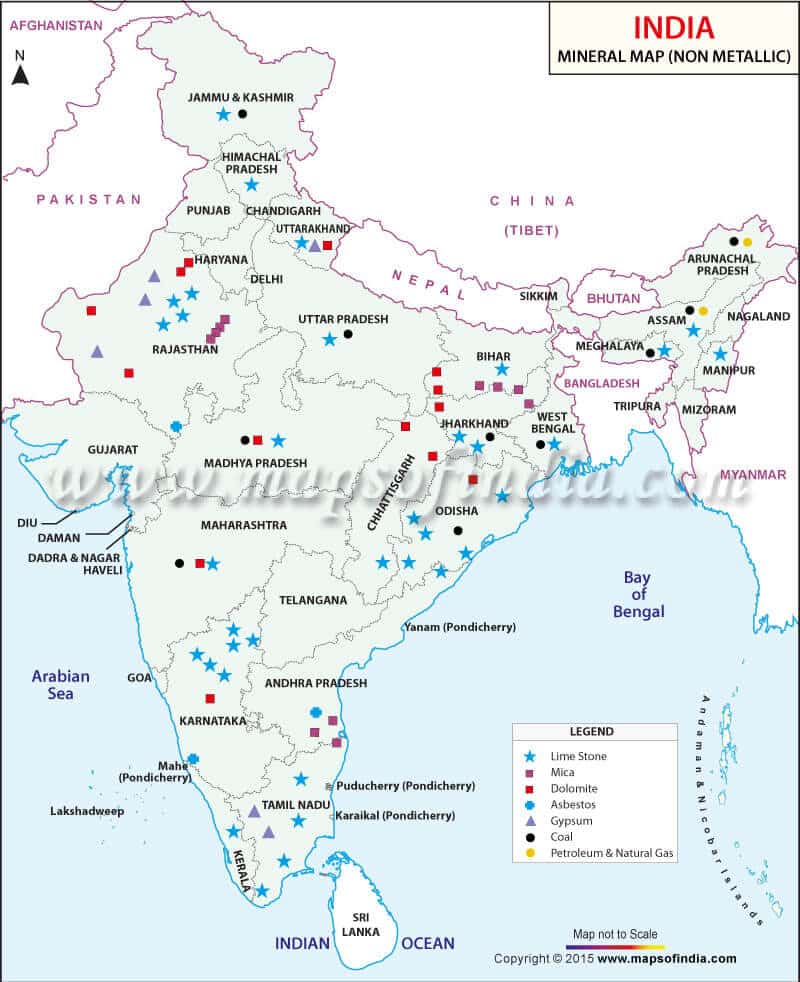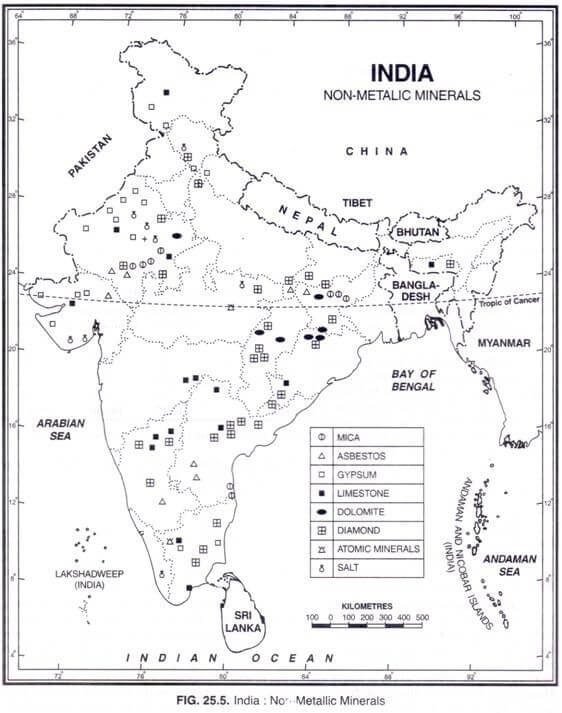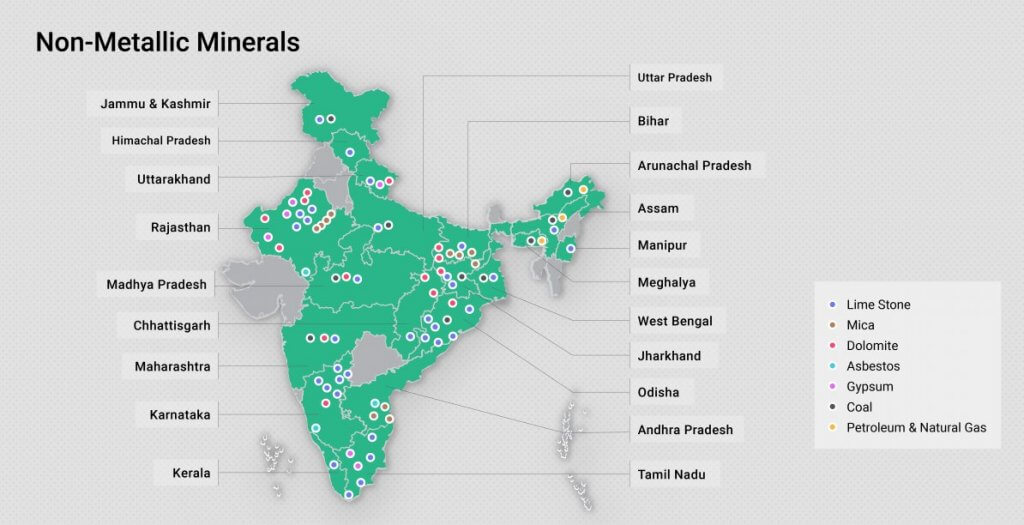In this article, You will read Mica, Limestone, Dolomite, Asbestos & other important Non-Metallic Minerals distribution in India – for UPSC IAS.
Mica
- Mica is a naturally occurring non-metallic mineral that is based on a collection of silicates. Mica occurs in the veins of the Metamorphic rocks.
- Mica is common in igneous and metamorphic rock and is occasionally found as small flakes in sedimentary rock.
- It is chemically inert, stable, and does not absorb water.
- Mica is a very good insulator that has a wide range of applications in the electrical and electronics industry.
- It can withstand high voltage and has a low power loss factor.
- It is used in toothpaste and cosmetics because of its glittery appearance. It also acts as a mild abrasive in toothpaste.
- It has a unique combination of elasticity, toughness, flexibility, and transparency.
Mica Reserves in India
- Mica is widely distributed in India, the minerals bearing Mica is found in the states of Andhra Pradesh, Maharashtra, Jharkhand, Odisha, Rajasthan, etc.
- State-wise total resource distribution of Mica is as follows:-
- Andhra Pradesh leads with 41% share in the country’s total resources followed by
- Rajasthan (21%)
- Odisha (20%)
- Maharashtra (15%)
- Bihar (2%) and
- The remaining 1% is in Jharkhand and Telangana together.
Mica Distribution in India
Andhra Pradesh:
- Andhra Pradesh is the largest mica producing state of India. In Andhra Pradesh. Nellore district produces the best quality mica.
- Vishakhapatnam, West Godavari, and Krishna are other important mica-producing districts.
Rajasthan:
- Second largest producer.
- In Rajasthan, the mica belt extends for about 320 kms from Jaipur to Bhilwara and around Udaipur.
- Bhilwara district located in this belt is the most imported producer of Mica.
Jharkhand:
- Third largest producer.
- Mica is found in a belt extending for about 150 km in length and 32 km in width from the Gaya district of Bihar to Hazaribagh and Koderma districts of Jharkhand. This Mica belt runs in an East-West direction. This belt contains the richest deposits of high-quality ruby mica.
- Kodarma (largest reserve of mica in the world), Giridih, and Domchanch are the chief collecting centers (located in this belt) where Mica is processed.
- Apart from this Munger in Bihar also have sufficient mica deposits.
- The main centres of mica production in this belt are Kodarma, Dhorhakola, Domchanch, Dhab, Gawan, Tisri, Chakai and Chakapathal.
Karnataka:
- Mica deposits occur in Mysuru and Hasan districts of Karanataka
Tamil Nadu:
- In Tamil Nadu, Coimbatore, Tiruchirapalli, Madurai and Kanniyakumari districts
Kerala:
In Kerala, Mica deposits are found in Alleppey district.
Maharashtra:
- Ratnagiri in Maharashtra has rich mica deposits.
West Bengal:
- Purulia and Bankura in West Bengal are known for mica deposits.
Mica Exports
- India is the largest exporter of mica.
- Certain grades of Indian mica are and will remain vital to the world’s electrical industries.
- Major exports are carried out through Kolkata and Vishakhapatnam ports.
- Important imports of Indian mica are Japan (19%), the USA (17%), U.K, etc.

Limestone
- Limestone is associated with rocks composed of either calcium carbonate, the double carbonate of calcium and magnesium, or a mixture of these two constituents. In addition to the main constituents of calcium and magnesium carbonates, limestone also contains small quantities of silica, alumina, iron oxides, phosphorus, and sulphur.
- Limestone deposits are of sedimentary origin and exist in all the geological sequences from Pre-Cambrian to Recent except in Gondwana.
- The two most important constituents are calcite and dolomite.
- Limestone is used for a large variety of purposes:
- Of the total consumption, 75 percent is used in the cement industry, 16 percent in the iron and steel industry, and 4 percent in the chemical industries.
- The rest of the limestone is used in paper, sugar, fertilizers, glass, rubber, and ferromanganese industries.
Limestone Distribution in India
- Limestone occupies the top position in India, among non-fuel solid mineral deposits as per volume of annual extraction. Given India’s rapid urbanization and the demand for housing as well as infrastructure, the demand for limestone is likely to increase further.
- State-wise total resource distribution of limestone is as following:-
- Karnataka is the leading state having 28% of the total resources followed by
- Andhra Pradesh, Gujarat, and Rajasthan (11% each),
- Telangana (9%),
- Chhattisgarh (5%),
- Madhya Pradesh (4%) and
- remaining 21% by other states.

As per 2014-15 data, State wise production of limestone:-
Rajasthan:
- As per 2014-15 data, Rajasthan was the leading producing state accounting for (21%) of the total production of limestone.
- Jhunjhunu, Banswara, Jodhpur, Ajmer, Bikaner, Dungarpur, Kota, Tonk, Alwar, Sawai Madhopur, Nagaur, etc. are the major limestone producing districts in Rajasthan.
Madhya Pradesh:
- Madhya Pradesh accounts for about 13% of limestone production in India.
- Jabalpur, Satna, Betul, Sagar, Damoh, and Rewa are the major limestone-producing districts in MP.
Andhra Pradesh:
- Andhra Pradesh accounts for about 12% of Limestone production in India.
- Cuddapah, Kumool, Guntur, Krishna are among the major deposits of limestone in Andhra Pradesh.
Gujarat:
- Gujarat accounts for about 9% Limestone production in India.
- Major limestone-producing districts in Gujarat are Amreli, Kachchh, Surat, Junagadh, Kheda, and Panchmahals.
Chhattisgarh:
- Chhattisgarh accounts for about 8% of limestone production in India.
- Major deposits of limestone occur in Bastar, Bilaspur, Raigarh, Raipur, and Durg districts.
Tamil Nadu:
- Tamil Nadu also accounts for about 8% of limestone production in India.
- Ramnathapuram, Tirunelveli, Tiruchchirappalli, Salem, Coimbatore, Madurai, and Thanjavur are the major limestone-producing districts in Tamil Nadu.
Karnataka:
- Karnataka accounts for about 8% limestone production in India.
- The major limestone-producing districts in Karnataka are Gulbarga, Chitradurg, Tumkur, Belgaum, Bijapur, Mysore, and Shimoga.
Telangana:
- Telangana accounts for about 8% of limestone production in India.
- Nalgonda, Adilabad, Warangal, Mahabubnagar and Karimnagar are among the major deposits of limestone in Telangana.
Other states:
- The remaining 5% was contributed by Meghalaya, Odisha, Uttar Pradesh, Jharkhand, Assam, Kerala, Bihar, and Jammu & Kashmir.
Dolomite
- Dolomite is an anhydrous carbonate mineral composed of calcium magnesium carbonate, ideally CaMg(CO₃)₂.
- The term is also used for a sedimentary carbonate rock composed mostly of the mineral dolomite. An alternative name sometimes used for the dolomitic rock type is dolostone.
- Dolomite rock which contains in addition to dolomite either Calcite or a mixture of Calcite & Magnesite are called ” Dolomitic Limestone”
- Dolomite is mainly used as blast furnace flux, as a source of magnesium salts, and in fertilizer and glass industries.
- The iron and Steel industry is the chief consumer of dolomite [90 percent] followed by fertilizer, ferroalloys, and glass.
- Dolomite is widely distributed in all parts of the country.
Dolomite Distribution in India
Chhattisgarh, the leading producing state of dolomite accounted for 39% of total production in 2014-15, followed by Andhra Pradesh (11%), Karnataka (10%) Madhya Pradesh (9%), Telangana (8%), Odisha (7%), Gujarat and Rajasthan (6% each). The remaining 4% was jointly shared by Jharkhand, Maharashtra, and Uttarakhand.
Chhattisgarh
- The main deposits occur in Bastar, Bilaspur, Durg, and Raigarh districts.
Orissa
- The main deposits occur in Sundargarh, Sambalpur, and Koraput districts.
Jharkhand
- Dolomite occurs in bands to the north of Chaibasa in Singhbhum district and Palamu district.
Rajasthan
- Ajmer, Alwar, Bhilwara, Jaipur, Jaisalmer etc. are the main producing districts.
Karnataka
- Belgaum, Bijapur, Chitradurga, Mysore, etc.

Asbestos
- Asbestos is a group of six naturally occurring fibrous silicate minerals.
- It is a commercially important mineral due to its fibrous character, infusibility, low heat conductivity, and high resistance to electricity & sound as also to corrosion by acids.
- Two quite different minerals are included under this name; one, a variety of amphibole, and the other, more important, a fibrous variety of serpentine (chrysotile).
- Chrysotile is more important variety and accounts for 80 percent of the asbestos of commercial use.
- Asbestos has great commercial value due to its fibrous structure, filaments of high tensile strength, and its great resistance to fire.
- It is widely used for making fire-proof cloth, rope, paper, millboard, sheeting, etc.
- It is also used in making aprons, gloves, brake-linings in automobiles, etc.
- Asbestos cement products like sheets, pipes, and tiles are used for building purposes.
- When asbestos is brittle, it is made into filter pads for filtering acids.
- Mixed with magnesia, it is used for making ‘magnesia bricks’ used for heat insulation.
Asbestos distribution
- Out of the total resources, Rajasthan accounts for 13.6 million tonnes (61%) and Karnataka 8.28 million tonnes (37%). The remaining two percent of resources are estimated in Jharkhand, Andhra Pradesh, Odisha, and Uttarakhand.
- In Rajasthan, important occurrences are known in Udaipur, Dungarpur, Alwar, Ajmer, and Pali districts.
- In Andhra Pradesh, asbestos of fine quality occurs in Pulivendla taluk of Cuddapah district.
- In Karnataka, the main deposits occur in Hassan, Mandya, Shimoga, Mysore, and Chikmaglur districts.
- Singhbhum district in Jharkhand
- Chamoli district in Uttarakhand.
Magnesite
- Magnesite is a carbonate of magnesium.
- It is an alteration product of dunites (peridotite) and other basic magnesian rocks.
- It is primarily used for manufacturing refractory bricks.
- It is also used as a bond in abrasives, manufacture of a special type of cement for artificial stone, tiles, and for extraction of the metal magnesium.
- The steel industry also uses magnesite.
- Major deposits of magnesite are found in Uttaranchal, Tamil Nadu, and Rajasthan.
- Tamil Nadu is the largest producer of magnesite in India.
- Tamil Nadu has one of the largest deposits of magnesite in the world and the largest in India are found at Chalk Hills near Salem town.
- Resources are also located in Andhra Pradesh, Himachal Pradesh, Jammu & Kashmir, Karnataka, and Kerala.
Production
- Tamil Nadu continued to be the major producing state with a maximum share of 78% in total output during 2014-15 followed by Uttarakhand (19% ), and the remaining 3% was contributed by Karnataka.
Kyanite
- Kyanite occurs as metamorphic aluminous rocks.
- It is primarily used in metallurgical, ceramic, refractory, electrical, glass, cement, and a number of other industries due to its ability to stand high temperatures.
- It is also used in making sparking plugs in automobiles.
- India has the largest deposits of kyanite in the world. All three grades of kyanite are found here. Kyanite grades depend on aluminium content. Greater the aluminium content, the greater the quality.
- Jharkhand, Maharashtra, and Karnataka produce practically the whole of kyanite of India.
- Major Kyanite deposits are located in –
- Saraikela in Jharkhand,
- Bhandara and Nagpur districts in Maharashtra,
- Chickmaglur, Chitradurga, Mandya, Mysore, Dakshin Kannad and Shimoga districts in Karnataka.
- State-wise, share of Telangana is 47% of total resources followed by Andhra Pradesh 31%, Karnataka 13% and Jharkhand 6%.
- Remaining 3% resources are in Kerala, Maharashtra, Rajasthan, Tamil Nadu and West Bengal.
Sillimanite
- The occurrence and uses of sillimanite are almost the same as those of kyanite.
- The main concentration of Sillimanite is found in Tamil Nadu, Orissa, Kerala, Andhra Pradesh, and West Bengal.
- Major deposits of sillimanite in India are located in –
- Ganjam district in Odisha,
- Kozhikode, Palakkad, Ernakulam, and Kottayam districts in Kerala,
- Bhandara district in Maharashtra,
- Udaipur district in Rajasthan and
- Hassan, Mysore, and Dakshin Kannada districts in Karnataka.
- State-wise, the resources are located mainly in Tamil Nadu (26%), Odisha (20%), Uttar Pradesh (17%), Andhra Pradesh (14%), Kerala (11%), and Assam (7%).
- Remaining 5% resources are in Jharkhand, Karnataka, Madhya Pradesh, Maharashtra, Meghalaya, Rajasthan, and West Bengal.
Gypsum
- Gypsum is a hydrated sulphate of calcium.
- It is a white opaque or transparent mineral.
- It occurs in sedimentary formations such as limestones, sandstones and shales.
- It is mainly used in making ammonia sulphate fertilizer and in the cement industry.
- It makes up to 4-5 per cent of cement.
- It is also used in making plaster of Paris, moulds in the ceramic industry, tiles, plastics, etc.
- It is applied as surface plaster in agriculture for conserving moisture in the soil and for aiding nitrogen absorption.
- Rajasthan is by far the largest producer of gypsum in India [81 percent of the total production of India].
- The main deposits occur in the Tertiary clays and shales of Jodhpur, Nagaur and Bikaner.
- Jaisalmer, Barmer, Chum, Pali and Ganganagar also have some gypsum bearing rocks.
- The remaining gypsum is produced by Tamil Nadu [Tiruchirapalli district], Jammu and Kashmir, Gujarat and Uttar Pradesh in order of production.
- By States, Rajasthan alone accounts for 81% resources, Jammu & Kashmir 14%, and Tamil Nadu 2% resources.
- The remaining 3% resources are in Gujarat, Himachal Pradesh, Karnataka, Uttarakhand, Andhra Pradesh, and Madhya Pradesh
Potash
- Potash is a common name of the fertilizer form of mineral potassium (K) which is abundantly available in nature.
- Resource distribution: Rajasthan alone contributes 94% to the total resources, followed by Madhya Pradesh (5%) and Uttar Pradesh (1%)
- Production: Indian reported occurrences are not commercially exploitable, and hence no production of potash is reported from India. The entire requirement of potash to be utilized as fertilizer is therefore met by imports.
- Occurrences: As far as India is concerned, few deposits of potash minerals are reported from –
- Satna & Sidhi districts of Madhya Pradesh,
- Sonbhadra district of Uttar Pradesh, and
- Jaisalmer, Chittorgarh, and Kota districts of Rajasthan.
Sulphur
- In India, there are no mineable elemental sulphur reserves.
- Pyrites were used as a substitute for sulphur in the manufacture of sulphuric acid. However, there was no production of pyrites since 2003.
- The domestic production of elemental sulphur is limited to by-product recoveries from petroleum refineries and fuel oil used as feedstock for manufacturing fertilizer.
Salt
- Salt is obtained from seawater, brine springs [salt water springs], wells, and salt pans in lakes and from rocks.
- India is the world’s third-largest producer of salt, after the US and China.
- Rock salt is taken out in the Mandi district of Himachal Pradesh and in Gujarat.
- Gujarat coast produces nearly half of our salt.
- Gujarat was the leading State followed by Tamil Nadu, Rajasthan, Andhra Pradesh, Maharashtra, West Bengal, Karnataka, Odisha, and Goa.

Thank you so much for such a good information may God bless you